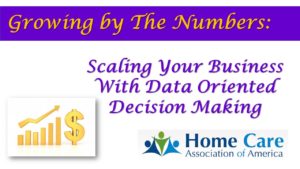By Stephen Tweed 
A few weeks ago, I presented the closing general session for one of the largest organizations in Home Care. I delivered a new keynote speech titled “Scaling Your Business with Data Oriented Decision Making.”
Of course, I included my favorite quote from W. Edwards Deming, “Without the Data, you are just another person with an opinion.” I was delighted after the presentation by the number of people from the audience who came up to ask questions about using data to grow their businesses. I was even more pleased by the number of folks who reached out to me after the meeting to inquire about working together on our Strategic Business Coaching process.
The Process of Visioneering Home Care
This process begins with an assessment of their business, and it always includes looking at the data to define “Where are we now?” Then we lead a Strategic Business Planning Session where we have the leadership team define their Five-year Vision, their Three-year Picture, and their One-year Goals. The leaders then define their three Core Values that will be the foundation of their Company Culture, and we help them define their source of Competitive Advantage in the local marketplace. Then we develop a One-year Action Plan
Defining Your Vision Critical Metric
Using our Vision Summary Worksheet, the team defines their “Vision Critical Metric”. This is the one number that truly measures the success of the business strategy, and the number that drives all of the other business metrics. For example, the most common vision critical metric used by home care companies in the top tier of our industry is “Hours per week”. Using this metric, you can track the growth of your business each week by tracking the exact number of hours of care delivered to your clients.
According to the 2022 Home Care Benchmarking Study from Home Care Pulse, the median sized company in home care generated $1,664,856 in annual revenue. According to the same study, the median bill rate for an 8 hour shift was $28.00. Doing the math, you can see that the median sized home care company provides 1,143.45 hours of care per week. So as you are working on your five year vision and your three year picture you can say …
“In three years, I want to be at $3 million in revenue, and that is 2,060 hours per week. And in five years I want to be at $5 million in revenue, so I need to deliver 3,434 hours per week.”
Why Use Hours Instead of Dollars?
When we are leading this process, some owners ask why we use hours instead of dollars as our Vision Critical Metric. The answer is, it is very difficult to motivate your office team to generate more dollars so you can lease a new luxury car or buy a vacation home. There is a tendency to translate dollars of revenue into dollars of profit and personal income for you, the owner.
On the other hand, I like to make the case that the reason to grow your business is to serve more clients. If you really believe that you provide the best quality care in your market, then every older adult deserves to have your company and your caregivers to provide their care. We can get our team enthused about growing the business to serve more clients and employ more caregivers and office team members. It’s a subtle difference, but it matters.
Driving Other Key Metrics
Once you are clear about tracking your Vision Critical Metric, then you can define the other metrics you want to track regularly. For example, some of the common metrics used by members of our Home Care Mastermind Groups are:
- Client inquiries
- In-home assessments
- Admissions
- New Clients
- New Hours
- Hours per week
- Average hours per week per client
- Number of clients served
When you have your scorecard established and are tracking your metrics, then you can begin to do some analysis to help you grow your business.
If you are doing 1,000 hours per week, and you average 20 hours per client per week, then you have 50 clients. To get to 2,000 hours per week, you need 100 clients. However, if you can shift your marketing to attract clients who want an average of 40 hours per week, you can get to 2,000 hours per week with only 50 clients.
If you are doing 1,000 hours per week, and your caregivers average 20 hours per week of work, you need 50 caregivers. To get to 2,000 hours per week, you will need to add 50 additional caregivers to get to 100 total. However, if you can recruit caregivers who will work an average of 30 hours per week, you will need 67 caregivers instead of 100.
These are some simple examples of how you can use data to make decisions and drive your business. Without the data, your are just another person with an opinion and you are guessing about your decisions.
* How do you use data in your business so that you are making strategic decisions based on more than your opinion?
* What have you learned about your business from assessing your own data?
* What is the one Vision Critical Metric that you use in measuring progress toward your own business vision?
Join me at HCAOA in Orlando for Scaling Your Business with Data Oriented Decision Making 
If you would like to learn more about how you can use data to make better strategic business decisions, you’ll want to join me in Orlando Florida at the Home Care Association of America annual conference. The theme this year is “Going Bold: Home Care Reimagined.” I’ll be speaking on Monday, September 19 from 1:45 to 2:45 on the topic “Scaling Your Home Care Business with Data Oriented Decision Making.” Hope to see you there.
You will also be able to hear our friend and colleague from The Home Care CEO Forum, Jensen Jones. Jensen will be speaking on “Intention Behind Retention: Innovative Approaches to Retain Your Caregivers.”




